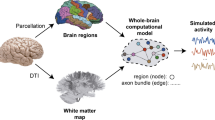Abstract
Emerging research areas in neuroscience are requiring simulation of large and detailed spiking neural networks. Although event-driven methods have been recently proposed to simulate these networks, they still present some drawbacks. To obtain the advantages of an event-driven simulation method and a traditional time-driven method, we present a hybrid method. This method efficiently simulates neural networks composed of several neural models: highly active neurons or neurons defined by very-complex model are simulated using a time-driven method whereas other neurons are simulated using an event-driven method based in lookup tables. To perform a comparative study of this hybrid method in terms of speed and accuracy, a model of the cerebellar granular layer has been simulated. The performance results showed that a hybrid simulation can provide considerable advantages when the network is composed of neurons with different characteristics.
Access this chapter
Tax calculation will be finalised at checkout
Purchases are for personal use only
Preview
Unable to display preview. Download preview PDF.
Similar content being viewed by others
References
Edlut official web site, http://edlut.googlecode.com
Bower, J.M., Beeman, D.: The Book of GENESIS: Exploring Realistic Neural Models with the GEneral Simulation System, 2nd edn. Springer, Heidelberg (1998)
Brette, R.: Exact simulation of integrate-and-fire models with synaptic conductances. Neural Computation 18, 2004–2027 (2006)
Coenen, O.J.-M., Arnold, M.P., Sejnowski, T.J., Jabri, M.A.: Parallel fiber coding in the cerebellum for life-long learning. Autonomous Robots 11, 291–297 (2001), http://dx.doi.org/10.1023/A:1012403510221 , doi:10.1023/A:1012403510221
Delorme, A., Gautrais, J., VanRullen, R., Thorpe, S.J.: Spikenet: A simulator for modeling large networks of integrate and fire neurons. Neurocomputing 26-27, 989–996 (1999)
D’Haene, M., Schrauwen, B., Campenhout, J.V., Stroobandt, D.: Accelerating event-driven simulation of spiking neurons with multiple synaptic time constants. Neural Computation 21, 1068–1099 (2009)
Gerstner, W., Kistler, W.M.: Spiking Neuron Models. Cambridge University Press, Cambridge (2002)
Hines, M.L., Carnevale, N.T.: The neuron simulation environment. Neural Computation 9, 1179–1209 (1997)
Kandel, E.R., Schwartz, J., Jessell, T. (eds.): Principles of Neuroscience. Elsevier, Amsterdam (1981)
Makino, T.: A discrete-event neural network simulator for general neural models. Neural Computing and Applications 11, 210–223 (2003)
O’Reilly, R.C., Munakata, Y.: Computational Explorations in Cognitive Neuroscience: Understanding the Mind by Simulating the Brain. MIT Press, Cambridge (2000)
Reutimann, J., Giugliano, M., Fusi, S.: Event-driven simulation of spiking neurons with stochastic dynamics. Neural Computation 15(4), 811–830 (2003), doi:10.1162/08997660360581912
Ros, E., Carrillo, R., Ortigosa, E.M., Barbour, B., Agis, R.: Event-driven simulation scheme for spiking neural networks using lookup tables to characterize neuronal dynamics. Neural Computation 18, 2959–2993 (2006)
Watts, L.: Event-driven simulation of networks of spiking neurons. Advances in Neural Information Processing Systems 6, 927–934 (1994)
Author information
Authors and Affiliations
Editor information
Editors and Affiliations
Rights and permissions
Copyright information
© 2011 Springer-Verlag Berlin Heidelberg
About this paper
Cite this paper
Garrido, J.A., Carrillo, R.R., Luque, N.R., Ros, E. (2011). Event and Time Driven Hybrid Simulation of Spiking Neural Networks. In: Cabestany, J., Rojas, I., Joya, G. (eds) Advances in Computational Intelligence. IWANN 2011. Lecture Notes in Computer Science, vol 6691. Springer, Berlin, Heidelberg. https://doi.org/10.1007/978-3-642-21501-8_69
Download citation
DOI: https://doi.org/10.1007/978-3-642-21501-8_69
Publisher Name: Springer, Berlin, Heidelberg
Print ISBN: 978-3-642-21500-1
Online ISBN: 978-3-642-21501-8
eBook Packages: Computer ScienceComputer Science (R0)




